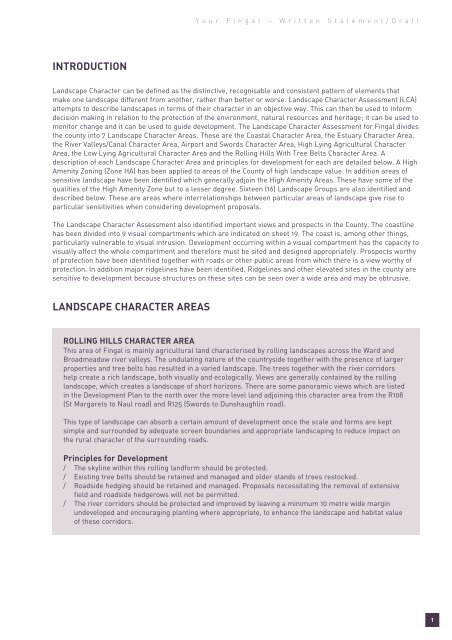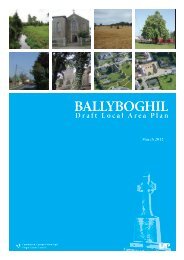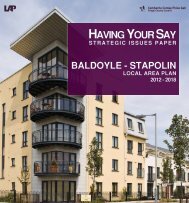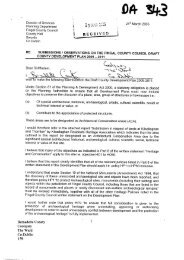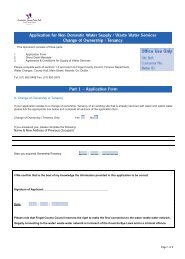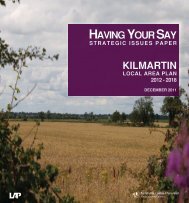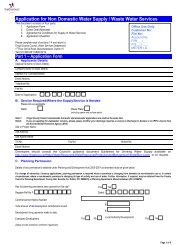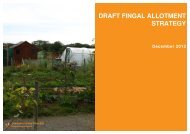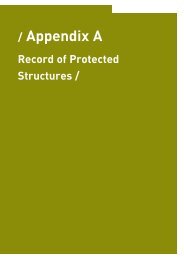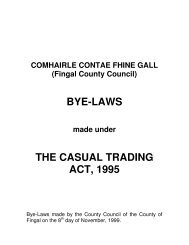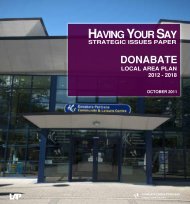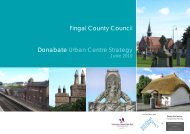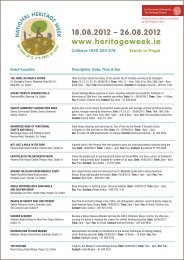Appendix Full - Fingal County Council
Appendix Full - Fingal County Council
Appendix Full - Fingal County Council
Create successful ePaper yourself
Turn your PDF publications into a flip-book with our unique Google optimized e-Paper software.
INTRODUCTION<br />
Your <strong>Fingal</strong> – Written Statement/Draft<br />
Landscape Character can be defined as the distinctive, recognisable and consistent pattern of elements that<br />
make one landscape different from another, rather than better or worse. Landscape Character Assessment (LCA)<br />
attempts to describe landscapes in terms of their character in an objective way. This can then be used to inform<br />
decision making in relation to the protection of the environment, natural resources and heritage; it can be used to<br />
monitor change and it can be used to guide development. The Landscape Character Assessment for <strong>Fingal</strong> divides<br />
the county into 7 Landscape Character Areas. These are the Coastal Character Area, the Estuary Character Area,<br />
the River Valleys/Canal Character Area, Airport and Swords Character Area, High Lying Agricultural Character<br />
Area, the Low Lying Agricultural Character Area and the Rolling Hills With Tree Belts Character Area. A<br />
description of each Landscape Character Area and principles for development for each are detailed below. A High<br />
Amenity Zoning (Zone HA) has been applied to areas of the <strong>County</strong> of high landscape value. In addition areas of<br />
sensitive landscape have been identified which generally adjoin the High Amenity Areas. These have some of the<br />
qualities of the High Amenity Zone but to a lesser degree. Sixteen (16) Landscape Groups are also identified and<br />
described below. These are areas where interrelationships between particular areas of landscape give rise to<br />
particular sensitivities when considering development proposals.<br />
The Landscape Character Assessment also identified important views and prospects in the <strong>County</strong>. The coastline<br />
has been divided into 9 visual compartments which are indicated on sheet 19. The coast is, among other things,<br />
particularly vulnerable to visual intrusion. Development occurring within a visual compartment has the capacity to<br />
visually affect the whole compartment and therefore must be sited and designed appropriately. Prospects worthy<br />
of protection have been identified together with roads or other public areas from which there is a view worthy of<br />
protection. In addition major ridgelines have been identified. Ridgelines and other elevated sites in the county are<br />
sensitive to development because structures on these sites can be seen over a wide area and may be obtrusive.<br />
LANDSCAPE CHARACTER AREAS<br />
ROLLING HILLS CHARACTER AREA<br />
This area of <strong>Fingal</strong> is mainly agricultural land characterised by rolling landscapes across the Ward and<br />
Broadmeadow river valleys. The undulating nature of the countryside together with the presence of larger<br />
properties and tree belts has resulted in a varied landscape. The trees together with the river corridors<br />
help create a rich landscape, both visually and ecologically. Views are generally contained by the rolling<br />
landscape, which creates a landscape of short horizons. There are some panoramic views which are listed<br />
in the Development Plan to the north over the more level land adjoining this character area from the R108<br />
(St Margarets to Naul road) and R125 (Swords to Dunshaughlin road).<br />
This type of landscape can absorb a certain amount of development once the scale and forms are kept<br />
simple and surrounded by adequate screen boundaries and appropriate landscaping to reduce impact on<br />
the rural character of the surrounding roads.<br />
Principles for Development<br />
/ The skyline within this rolling landform should be protected.<br />
/ Existing tree belts should be retained and managed and older stands of trees restocked.<br />
/ Roadside hedging should be retained and managed. Proposals necessitating the removal of extensive<br />
field and roadside hedgerows will not be permitted.<br />
/ The river corridors should be protected and improved by leaving a minimum 10 metre wide margin<br />
undeveloped and encouraging planting where appropriate, to enhance the landscape and habitat value<br />
of these corridors.<br />
1


